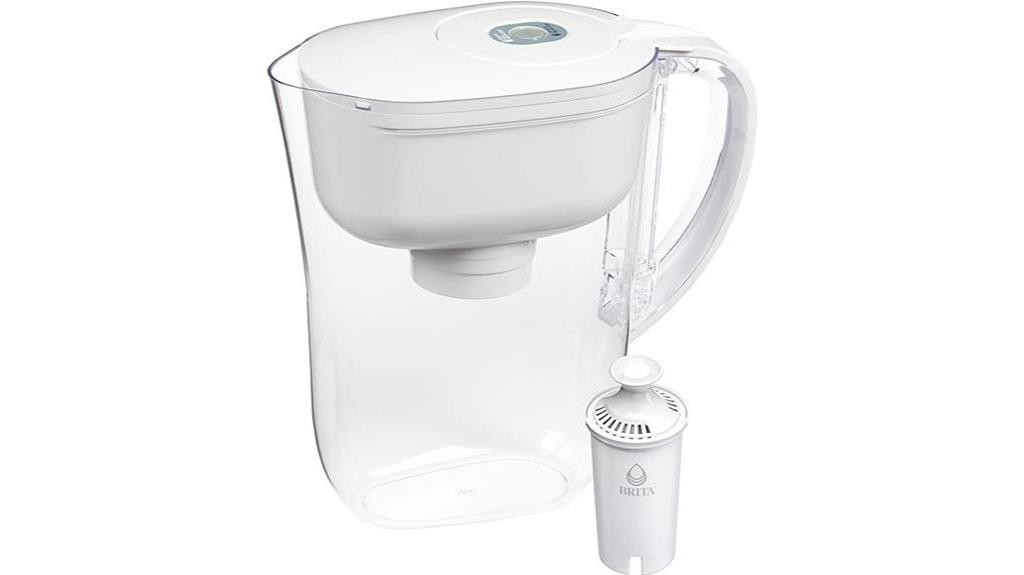You may not realize it, but every time you drink a glass of water, you could also be consuming microplastics. These tiny pieces of plastic can be found in tap water, bottled water, and even in water from natural sources like rivers and lakes. The presence of microplastics in water is a growing concern, as they can lead to serious health problems such as inflammation, DNA damage, and oxidative stress.
You may be wondering if there is anything you can do to protect yourself from the harmful effects of microplastics in water. One solution that many people turn to is using a Brita filter. But can these popular water filters actually help remove microplastics?
In this article, we will explore the science behind microplastics in water, the effectiveness of Brita filters in removing them, and what actions you can take to reduce your exposure to microplastics.
Key Takeaways
– Microplastics are small pieces of plastic found in tap water, bottled water, and natural sources like rivers and lakes, and they can lead to health problems such as inflammation, DNA damage, and oxidative stress.
– The average person consumes 39,000 to 52,000 particles of microplastics per year, and they can accumulate in the environment, posing a threat to wildlife and ecosystems.
– Using a Brita filter can help reduce the presence of microplastics in drinking water, as Brita filters are certified to remove suspended solids between 0.001mm and 1mm, and their Longlast and Longlast+ filters remove 99.6% of Class I particles (0.5 to 1 micron).
– Advocating for government and industry action, supporting businesses that prioritize sustainability, and educating yourself and others about the issue of microplastics in water are all important steps towards reducing plastic waste and improving water quality.
What Are Microplastics?
You may not realize it, but tiny pieces of plastic from various sources, known as microplastics, are present in oceans, rivers, lakes, and even 94% of US tap water. These particles come from sources such as plastic bags, bottles, and packaging, as well as from synthetic textiles and personal care products like toothpaste and exfoliating scrubs.
Microplastics can range in size from 5 millimeters to less than 1 micron, and the average person consumes 39,000 to 52,000 particles per year.
The environmental impact of microplastics is a growing concern globally. These particles cannot be broken down and can accumulate in the environment, posing a threat to wildlife and ecosystems. They can also absorb and release harmful chemicals, leading to bioaccumulation in the food chain.
More research is needed to fully understand the impact of microplastics on human health, but it’s clear that reducing their presence in the environment is crucial for the health of both humans and the planet.
Can Brita Filters Remove Microplastics?
One option for reducing the presence of tiny plastic particles in your drinking supply is by using a filtration system that’s certified for removing suspended solids, such as a Brita filter. Brita filters are certified to remove suspended solids between 0.001mm and 1mm, and their Longlast and Longlast+ filters remove 99.6% of Class I particles (0.5 to 1 micron).
Additionally, Brita’s faucet filters are certified to NSF/ANSI Standard 42 for removal of suspended solids. While the standard filter isn’t certified for removal of particulates, Brita filters are likely very effective at removing microplastics.
However, it’s important to note that while microplastics are a growing concern globally, more research is needed on their impact on human health. The US EPA hasn’t established a maximum contaminant level for microplastics, but studies have shown that the average person consumes 39,000 to 52,000 particles per year.
Microplastics can lead to oxidative stress, DNA damage, inflammation, and serious health problems. Therefore, while using a Brita filter can help reduce the presence of microplastics in your drinking water, it’s also important to educate yourself on the potential impact on your health and take action to reduce plastic waste in other areas of your life.
What Can We Do About Microplastics in Water?
To address the issue of microplastics in our drinking supply, consider using reusable water bottles and advocating for government and industry action to reduce plastic waste. Not only will using reusable bottles help reduce plastic waste, but it can also prevent the consumption of microplastics found in bottled water.
Additionally, by advocating for government and industry action, we can work towards reducing the amount of plastic waste entering our water supply and ultimately decreasing the presence of microplastics.
Here are five actions you can take to help address the issue of microplastics in water:
– Use reusable water bottles to reduce plastic waste and prevent the consumption of microplastics in bottled water.
– Advocate for government action to implement policies and regulations that reduce plastic waste and improve water quality.
– Support businesses that prioritize sustainability and reduce their plastic waste.
– Educate others about the issue of microplastics in water and encourage them to take action.
– Consider using a water filtration system, such as a Brita filter, to help reduce the presence of microplastics in your drinking water.
Conclusion
Great job! You’ve just finished reading about the potential dangers of microplastics in our water and whether Brita filters can help alleviate this problem.
While it’s true that microplastics are a serious concern for human health, there’s good news. Brita filters can indeed help remove these tiny particles from our drinking water.
But don’t stop there. We all have a role to play in reducing plastic waste and preventing microplastics from entering our waterways in the first place. By making small changes in our daily lives, such as using reusable water bottles and reducing single-use plastics, we can make a big difference.
Let’s take action together to protect our health and our planet.
